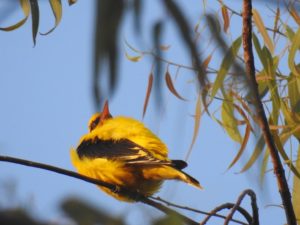Regional Museum of Natural History, Bhopal (A Regional Centre of National Museum of Natural History, New Delhi) and Bhopal Birds NGO jointly organized ‘Campus Bird Count Programme’ on 14th February, 2020. The motive of this programme was to keep a track of the species which are not so regular in the campus.
Approx 30 species of birds were spotted during this bird count. large cormorant, Grey Hornbill, Rose Ringed Parakeet, Lesser White Throat, white eye, purple sun bird, booted warbler, greenish leaf warbler, jungle babbler, Bulbul, golden oriole, thick billed flower packer, grey headed fly catcher, Ibis, Laughing Dove etc. were the prominent among these birds.
Know these birds

- Large cormorant: Also known as the great black cormorant across the Northern Hemisphere, the great cormorant across Australia, the large cormorant in India and the black shag further south in New Zealand, is a widespread member of the cormorant family of seabirds.
- Grey Hornbill: The Indian grey hornbill (Ocyceros birostris) is a common hornbill found on the Indian subcontinent. It is mostly arboreal and is commonly sighted in pairs. It has grey feathers all over the body with a light grey or dull white belly.
- Rose Ringed Parakeet: Also known as the ring-necked parakeet, is a medium-sized parrot in the genus Psittacula, of the family Psittacidae. It has disjunct native ranges in Africa and South Asia, and is now introduced into many other parts of the world where feral populations have established themselves and are bred for the exotic pet trade.
- Lesser White Throat: It is a common and widespread typical warbler which breeds in temperate Europe, except the southwest, and in western and central Asia. This small passerine bird is strongly migratory, wintering in Africa just south of the Sahara, Arabia and India.
- Purple sun bird: It is a small bird in the sunbird family found mainly in South and Southeast Asia but extending west into parts of the Arabian Peninsula. Like other sunbirds they feed mainly on nectar, although they will also take insects, especially when feeding young.
- Greenish leaf warbler: is a widespread leaf warbler with a breeding range in northeastern Europe and temperate to subtropical continental Asia. This warbler is strongly migratory and winters in India.
- Booted warbler: It is an Old World warbler in the tree warbler group. It was formerly considered to be conspecific with Sykes’s warbler, but the two are now usually both afforded species status.
- Jungle babbler: is a common resident breeding bird in most parts of the Indian subcontinent and is often seen in gardens within large cities as well as in forested areas.
- Bulbul: The bulbuls are a family, Pycnonotidae, of medium-sized passerine songbirds. Many forest species are known as greenbuls, brownbuls, leafloves, or bristlebills.
- Thick billed flower packer: It is a tiny bird in the flowerpecker group. They feed predominantly on fruits and are active birds that are mainly seen in the tops of trees in forests. It is a resident bird with a wide distribution across tropical southern Asia from India east to Indonesia.
- Grey headed fly catcher: It is a species of small flycatcher-like bird found in tropical Asia. It has a square crest, a grey hood and yellow underparts.
- Ibis: They are a group of long-legged wading birds in the family Threskiornithidae, that inhabit wetlands, forests and plains. “Ibis” derives from the Latin and Ancient Greek word for this group of birds.
- Laughing Dove: It is a small pigeon that is a resident breeder in Africa, the Middle East and the Indian Subcontinent. This small long-tailed dove is found in dry scrub and semi-desert habitats where pairs can often be seen feeding on the ground.
During the programme In-charge of the museum Dr. Manoj Kumar Sharma, Scientist-B Manik Lal Gupta, Photogrpher Gautam Singh Yadav, Stenographer-II Shri Sushil Kumar Chourey, Contrautual Driver Mohd. Shahid and Dr. Sangeeta Rajgir and Mohammad Khalique from Bhopal Birds NGO were present during this Campus Bird Count Programme.





